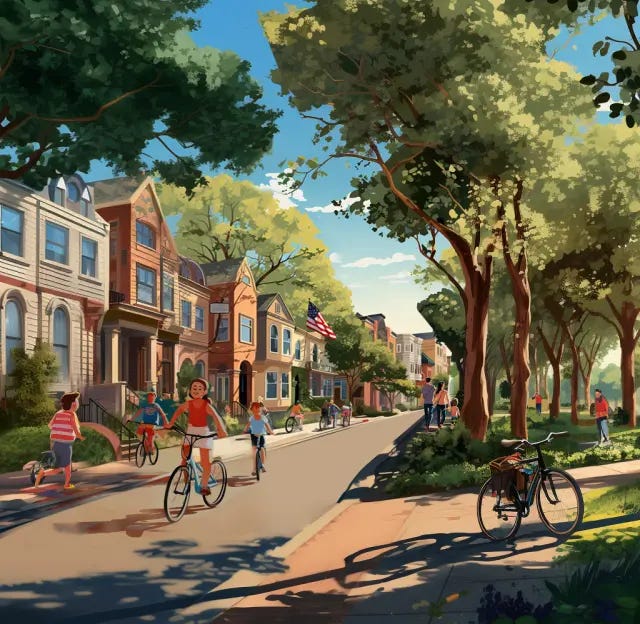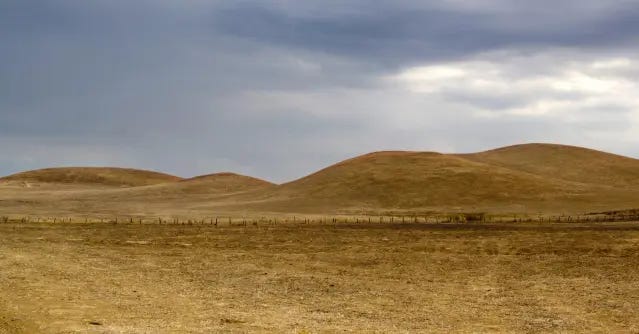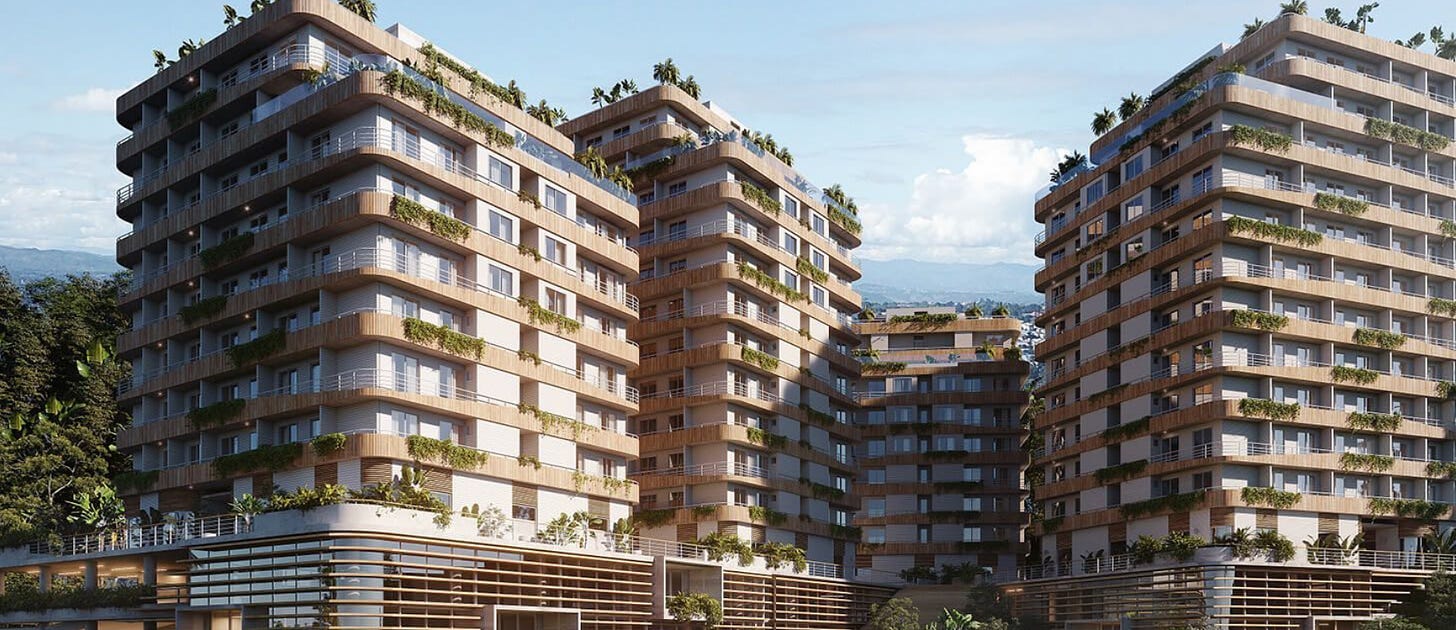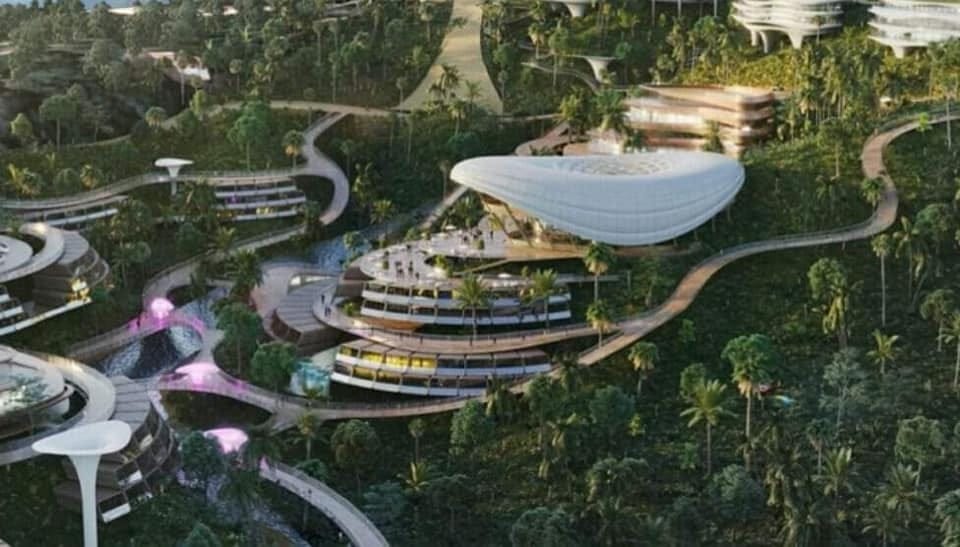Model City Monday 9/4/23: California Dreamin'
California Dreamin’
Guardian: Silicon Valley Elites Revealed As Buyers Of $800 Million In Land To Build Utopian City.
The specific elites include the Collison brothers, Reid Hoffman, Nat Friedman, Marc Andreessen, and others, led by the mysterious Jan Sramek. The specific land is farmland in Solano County, about an hour’s drive northeast of San Francisco. The specific utopian city is going to look like this:
 Source: www.californiaforever.com
Source: www.californiaforever.com
The company involved (Flannery Associates aka California Forever) has been in stealth mode for several years, trying to buy land quietly without revealing how rich and desperate they are to anyone in a position to raise prices. Now they’ve released a website with utopian Norman-Rockwell-esque pictures, lots of talk about creating jobs and building better lives, and few specifics.
My in-laws live just north of the area involved. I drive through there regularly. It’s hot, dry, and without a lot going on. There are a few ~100,000 person towns scattered across the county, usually a small core of shops surrounded by suburbs and strip malls. The culture and politics are about 30% of the way along the spectrum from Bay Area Democrats to Central Valley Republicans. Humans outnumber cows, but the cows make a strong showing.
 Source: www.californiaforever.com
Source: www.californiaforever.com
Even for these tech tycoons, $800 million is a lot of money. So what’s the business plan?
In one sense, nothing could be simpler. Buy lots of farmland cheap. Build housing for the housing-starved California masses. Once it’s a respectable-sized town, sell dear. If you can actually create a Norman Rockwell utopia, great. But Californians will also pay $750 per square foot for somewhere that just has a little less trash and feces than usual. So the bar is low.
Some quick numbers: Flannery has bought about 78 square miles of land, but suppose they can only develop half of it for legal and environmental reasons. This would still make them the same size as the nearby towns of Vacaville (30 sqm) and Fairfield (40 sqm). Land value in Vacaville is about $75K per acre. So if they developed their land to the same level as Vacaville, it would be worth $4 billion. But in fact, they’re talking a lot about “walkable, liveable, sustainable communities”, all of which are code words for “dense”. If their town actually looks like the pictures (note the connected row houses with tiny yards) it could easily be $10 billion plus. That’s not even counting any benefit from the community actually being “utopian”.1
In another sense, this is an extremely risky investment with a long and unclear path to profitability. You can make a killing selling housing in California because there’s constricted supply. There’s constricted supply for legal reasons. Building your own town routes around some, but not all, of the legal problems. And it causes new legal problems of its own.
Solano County has a so-called “Orderly Growth Measure” saying that new building should happen in existing cities and not on empty land. In order to start building at all, Flannery has to win a referendum granting an exemption. But they already have a powerful coalition of local enemies:
-
Three months ago, Flannery sued a group of local farmers who wouldn’t sell to them, accusing them of “conspiring to inflate the value of the land”. This isn’t implausible - a known risk of trying to buy lots of contiguous land without eminent domain powers is that locals realize you’re desperate and conspire to raise prices. But it’s also not implausible that billionaires trying to get farmers to sell their land are playing legal hardball. In any case, local officials and farming activist groups took the farmers’ side and are now really mad.
-
Local congressman John Garamendi noticed the weird land purchases, saw they were close to a military base, and spent years raising the alarm that it must be some sort of Communist Chinese conspiracy. He went to the press, pressured the military and intelligence communities, and generally made a big issue of it. Now (reading between the lines) he’s furious at Flannery for humiliating him, and (speaking about the national security issues and the farmer issues) described the company as “engaged in despicable, secretive, terrible practices.”
-
Solano County Orderly Growth Committee is a forty-year-old “watchdog and community action group” ensuring nobody builds anything outside existing cities in Solano County. They are pro-farm, pro-wilderness, and anti-”endless and sprawling subdivisions”. They haven’t yet expressed an opinion on Flannery but it seems like the epitome of the thing they exist to prevent.
-
According to this article, the mayor of nearby Suisun City, Princess Washington, worries that it will be “a city for the elite”. Although her concerns seem misplaced, her name makes her sounds like a powerful and majestic opponent.
-
According to this article, State Senator Bill Dodd2 worries that a new city might have an “impact on agricultural production”, “harm Travis Air Force Base”, and cause “suburban sprawl”.
And if they defeat all these people and win the local election, anyone who is against them can still lodge the normal CEQA and NEPA objections that have gummed up most large building projects in California over the past fifty years.
And if they defeat those , they still have to build the city. Rep. Garamendi is skeptical, saying3:
I think it’s pie in the sky. We know this area. I’ve talked to a very seasoned developer in California and asked what do you think of that? He said, keep in mind that the land is about 1/10th of the actual cost of building the city. You’ve got streets and roads and sewer systems and sanitation. They even want to build a concert hall.
And if they manage that , what do they do about their own citizens? California allows a local government form called a “charter city”, but I don’t think you can get away with being actually undemocratic. So once 10,000 people live in their town, what’s to stop those people from becoming NIMBYs and voting against further growth? I assume there’s some answer to this question, since people have built successful company-owned planned cities in California in the past (eg Irvine). I’m just not sure what it is. Could their city charter ban zoning? Could they have some sort of super-powerful city manager paired with a very weak democratic council? Could they build everything first, and only invite people to move in after they’re done?
Of course there are prediction markets:
This is the only one with more than 15 traders, but go here to see the smaller ones; I’ll try to highlight them later if they get big enough to be credible. Also, some people asking the important questions:
The Paradox Of Praxis
You can think of new city projects as existing on a spectrum:
Usually the ones on the left are more fun to talk about, but the ones on the right are more fun to invest in.
The paradox of Praxis is that to all appearances, they’re several miles off the left side of this graph. No amount of reading starry-eyed overly-ambitious Silicon Valley ad copy can prepare you for how over-the-top Praxis is. Praxis has a manifesto with phrases like “glory in death by a light brighter than a thousand suns” and “atrophied bodies submerged in gel, fed a synthetic bug paste”. Praxis holds parties in classical-music-filled candlelit lofts where they ask participants about “Janusian thinking”. Praxis has a website www.terrifyingangel.com which is just a YouTube video on the idea of meaning throughout human history, plus a resignation letter you can send to your boss when you quit to join Praxis.
 Seen on the Praxis founder’s Twitter account. Milady is some kind of NFT thing, otherwise it makes as much sense to me as it does to you.
Seen on the Praxis founder’s Twitter account. Milady is some kind of NFT thing, otherwise it makes as much sense to me as it does to you.
But the other half of the paradox is the constant rumors that they’re competent and have some kind of good plan. These are spoken only in hushed whispers, I don’t know the details. But in 2021, they raised $4 million in a seed round from well-regarded venture capitalists whose investments usually make money. In 2022 they raised another $15 million in a Series A round from . . . okay, partly from Sam Bankman-Fried and Three Arrows Capital, two notorious crypto scammers. But you would think scammers would be extra careful not to invest their own money in scams! Also, they recently signed on David Weinreb, a completely normal (and well-regarded) city planner person. What’s the strategy that both involves both Milady Raves and lots of competent people agreeing you’re a good investment?
One strategy is something like: buy some land somewhere. Build some houses and streets. Convince digital nomads to move there on the grounds that you are very cool and visionary. Do some cool and visionary seeming things, or at least throw some really good raves. Other digital nomads get jealous and move there too. Sell parcels of land to these people, get rich, pay back your investors. And then who knows, maybe create a new civilization that redefines what it means to be human.
Consider Elon Musk. Elon Musk is good at certain business-related skills. But that’s not the essence of Elon Musk. The essence of Elon Musk is that he’s a Visionary who can bring the Glorious Future. We know this because he’s a crazy person who says stuff that doesn’t really make sense. When Elon Musk buys a company, its value goes up - maybe partly because people expect Musk to make good business decisions, but also partly because now the company is part of Musk’s Glorious Future, and therefore exciting. Employees, customers, and investors all get excited and reinforce each other in a virtuous circle. And although Musk might not always accomplish the exact Glorious Future future he promises, his companies do well and make money, because having motivated employees, star-struck customers, and willing investors is a great combination.
Elon Musk has an aura of destiny because he succeeded at his first several companies. Dryden Brown of Praxis Society, lacking a Paypal Mafia to join, is trying to hack together an aura of destiny out of raves and angel-related videos. So far it seems to be going pretty okay.
Prospera Sues Honduras For 2/3 Of Its National Budget
To refresh: in the mid-2010s Honduras’ pro-market government created ZEDEs - businesses that bought up unoccupied land could start their own districts with their own preferred legal system in exchange for bringing in investment.
The government knew businesses wouldn’t invest long-term if the next government could just cancel the agreement and seize all of their stuff, so they fortified the law with as much protection as possible. It would take a long constitutional amendment process to repeal, and ZEDE investors might be able to object to any changes under international investment treaties. Lured by these protections, three companies started ZEDEs, including a big high-profile one called Prospera.
In early 2022, a socialist government took power, and started trying their best to destroy the ZEDEs. They started the constitutional amendment process (they seem to think they’ve finished it, but a Prospera rep I talked to believe they have to hold another vote by the end of this year, something I see no signs of them doing) and have been harassing and stonewalling existing ZEDEs. One ZEDE, Orquidea, shut down immediately. A second, Ciudad Morazan, seems to still be operating but I cannot figure out exactly how or why. Prospera has been most vocal in its opposition, and sued Honduras for $11 billion in the World Bank’s court of investment arbitration.
(Prospera has only spent about $100 million so far, so it’s unclear why they deserve 100x that in penalties. Also $11 billion is “two-thirds of the 2022 Honduran national budget”, and forcing Honduras to pay it would cause national catastrophe. This might be more of a highball offer than a number they actually expect to get.)
This article (poorly translated from Spanish, sorry) has the most information. It suggests Honduras believes they signed onto the investment treaties “with reservations”, ie conditional on being allowed to do things like shut down ZEDEs, and that therefore the suit is meaningless and they will not defend themselves. Although the magazine is on the government’s side of the overall issue, it suggests they didn’t actually sign on with reservations, that the country’s lawyers might just have no idea what they’re talking about, and that their bold strategy of refusing to defend themselves will not pay off. In contrast, Prospera has prestigious lawyers specializing in exactly this area, so things aren’t looking good for the government.
Honduras seems to recognize this and is threatening to withdraw from ICSID, the international investment treaty that governs such disputes. This wouldn’t be completely unprecedented - Venezuela, Bolivia, and Ecuador have also done this. But ICSID rules say that withdrawing from ICSID, while it might help prevent future cases against you, doesn’t cancel existing cases, and wouldn’t protect Honduras against Prospera’s claim.
(How would ICSID collect against Honduras if they lost? I don’t know, but I assume the global financial order has some way to make your life worse if you defy it.)
I think everyone is hoping Honduras realizes that cancelling a flourishing economic zone that’s bringing lots of investment into the country at no cost to them - just isn’t worth taking an $11 billion loss, cancelling international treaties, and scaring off future investment. But who knows how these people think?
In other Prospera news:
-
Prospera announces another $36 million in recent investment, which I take as evidence that VCs with good lawyers and research departments also think its case is very strong.
-
Niklas Anzinger has written The Ultimate Prospera Guide For Entrepreneurs, with advice for Hondurans, tech entrepreneurs, and others about how and why to get involved.
-
A representative says that “There are [now] 1,000 eResidents, the people who’ve signed up and paid and done the KYC/AML.”
-
Building progress: last I heard Duna Residences were supposed to be ready Q2 2023, but a recent video shows them still under construction. In March, Prospera said they would be “breaking ground on Pristine Heights” soon, but there have been no further updates. And a representative says they still plan to start Beyabu (futuristic-looking Zaha Hadid buildings) “the second half of this year”.
 Duna Residences (website)
Duna Residences (website)
 Pristine Heights (website)
Pristine Heights (website)
 Beyabu (website)
Beyabu (website)
-
Here’s a documentary on Minicircle, the biotech company in Prospera.
-
Satuye, the industrial mainland half of Prospera, “is almost fully subscribed”, with a major client being healthcare manufacturer CIGA
-
As originally promised, they now have a Montessori school.
Elsewhere In Model Cities
1:Dubai to help set up free trade zone in Colombia? (speculative, I’ve heard nothing else about this and don’t know what it would involve)
2:Financial Times article on recent charter city developments in Africa.
3: Saudi Arabia’s bonkers megacity Neom “is seeking a $2.7 billion loan”. I notice I am confused - I thought that despite all of Neom’s disadvantages, its one unquestionable advantage was that it was backed by the Saudi state who were willing to spend upwards of $1 trillion on it. So why do they need a $2.7 billion loan?
4: New Substack Vanguard Anthology on the Danish anarchist “free city” of Christiania. I visited when I was in Copenhagen, I mostly remember it being dirty and hard to navigate.
[ had link to story about France selling Kerguelen Island here, but it might be false; removing while I investigate]
-
I don’t know if this is the right way to think about things; it’s assuming that Flannery’s costs and profits both come mainly from land, and developers bear the costs and get the profits of buildings. But maybe that’s not the plan.
-
I wondered why that name seemed so familiar before remembering I used it for a minor character in Unsong , who was based off the Biblical character Bildod from Job 2:11. Bildod falsely accuses Job of being wicked, for which God condemns him and demands he make a compensatory sacrifice. This is not a coincidence because nothing is ever a coincidence.
-
See footnote 1. Flannery has spent $800 million. Eyeballing the sizes of the fortunes involved, the backers don’t have $8 billion to spend on further development, but I expect other investors will be happy to bear the cost of development once they’ve proven this is really going to happen.

